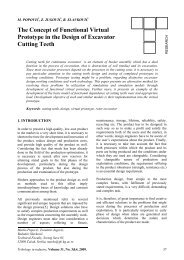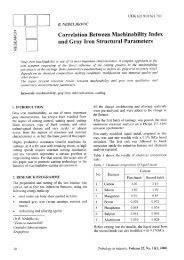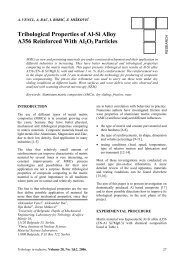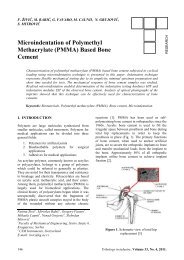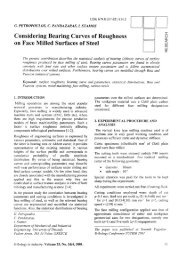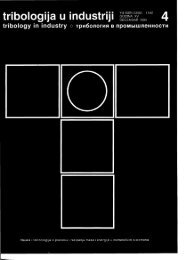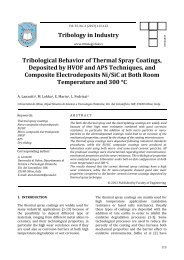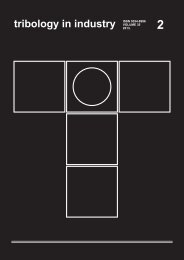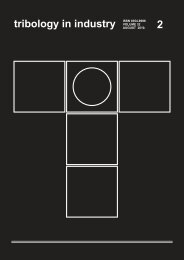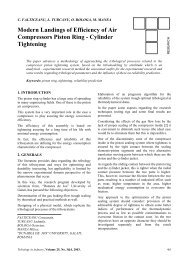Heat Exchanger Tube to Tube Sheet Joints Corrosion Behavior
Heat Exchanger Tube to Tube Sheet Joints Corrosion Behavior
Heat Exchanger Tube to Tube Sheet Joints Corrosion Behavior
You also want an ePaper? Increase the reach of your titles
YUMPU automatically turns print PDFs into web optimized ePapers that Google loves.
Vol. 35, No. 1 (2013) 19‐24Tribology in Industrywww.tribology.fink.rsRESEARCH<strong>Heat</strong> <strong>Exchanger</strong> <strong>Tube</strong> <strong>to</strong> <strong>Tube</strong> <strong>Sheet</strong><strong>Joints</strong> <strong>Corrosion</strong> <strong>Behavior</strong>M. Iancu a , R.G. Ripeanu b , I. Tudor ba OMV PETROM S.A., Brazi, Trandafirilor, No.65, 107080, Romania.b Petroleum‐Gas University of Ploiesti, Blvd. Bucuresti, No.39, 100680, Romania.Keywords:<strong>Tube</strong> <strong>to</strong> tube sheet fittingsStress<strong>Corrosion</strong> rateHydrofining oilTemperatureCorresponding author:Razvan George RipeanuPetroleum‐Gas University of Ploiesti,Blvd. Bucuresti, No.39, 100680,RomaniaE‐mail: rrapeanu@upg‐ploiesti.roA B S T R A C TPaper presents the studies made by the authors above the tube <strong>to</strong> tube sheetfittings of heat exchanger with fixed covers from hydrofining oil reformingunit. <strong>Tube</strong> fittings are critical zones for heat exchangers failures. On a devicemade from material tube and tube sheet at real joints dimensions wereestablish axial compression force and traction force at which tube isextracted from expanded joint. Were used two shapes joints with two typesof fittings surfaces, one with smooth hole of tube sheet and other in which onboring surface we made a groove. From extracted expanded tube zoneswere made samples for corrosion tests in order <strong>to</strong> establish the corrosionrate, corrosion potential and corrosion current in working mediums such ashydrofining oil and industrial water at different temperatures. Thecorrosion rate values and the temperature influence are important <strong>to</strong>evaluate joints durability and also the results obtained shows that theboring tube sheet shape with a groove on hole tube shape presents a bettercorrosion behavior then the shape with smooth hole tube sheet.© 2013 Published by Faculty of Engineering1. INTRODUCTIONShell and tube heat exchangers are mostcommonly used in the process refineryindustries due <strong>to</strong> a large ratio of heat transferarea <strong>to</strong> volume and weight. The tubes are thebasic component of the heat exchanger,providing the heat transfer surface between onefluid flowing inside the tube and the other fluidflowing across the outside of the tubes. Thetubes are held in place by being inserted in<strong>to</strong>holes in the tube sheet and there eitherexpanded in<strong>to</strong> grooves cut in<strong>to</strong> the holes orwelded <strong>to</strong> the tube sheet were the tubeprotrudes from the surface. The main failures ofheat exchangers are: corrosion of tubes andjacket, tubes blockage and failures of tube <strong>to</strong>tube sheet joints. Paper presents the studiesmade by authors above the tube <strong>to</strong> tube sheetfittings of heat exchanger, type BEM as classifiedof Tubular <strong>Exchanger</strong> ManufacturersAssociation, with fixed covers from hydrofiningoil reforming unit, [1]. In Fig. 1 is presented thecatalytic reforming unit of hydrofining oilschema were heat exchanger has position “121‐S1”. Weldings between tubes and tube sheet isnot recommended [2,3,4]. At studied heatexchanger the tube <strong>to</strong> tube sheet are expanded19
M. Iancu et al., Tribology in Industry Vol. 35, No. 1 (2013) 19‐24joints. The tubes and tube sheet, in addition <strong>to</strong>mechanical requirements, must withstandcorrosive attack by both fluids in the heatexchanger and must be electrochemicallycompatible with the tube and all tube‐sidematerial [1,2,3].Fig. 1. Catalytic reforming unit schema.At heat exchanger analyzed through the jacket iscirculating hydrofining oil and through the tubesis circulating industrial water. In Table 1 arepresented the main working conditions.Table 1. Main working conditionsParameter Jacket <strong>Tube</strong>sMaximum workingpressure, MPa1.15 0.65Maximumtemperature, 0 C70 38Minimumtemperature, 0 C50 30Working mediumDangerHydrofiningoilToxic,inflammableIndustrialwaterThe mechanical process of expanding of tubecomprises two distinct phases, [4]:a) pre expanding of tube, that preliminaryflexible flare or / and elastic‐plastic the tubularelement (TE) until it comes in contact with thewall tube sheet hole (TP);b) proper expanding of tube, additionalenlargement mainly concerned elastic‐plastic,residual TE, while broadening mainly flexible,reversible, the holes in TP as shown in Fig. 2, [4].‐Fig. 2. Typical characteristic curves of TE materialsand, respectively, TP regarded as joint materialsbuilding plastic linear hardening.Pre expanding of tube phase corresponds <strong>to</strong> fulldepletion clearance of assembly δ 0 = 2δ (Fig.3), [4].Fig. 3. <strong>Tube</strong> <strong>to</strong> tube sheet schemaThe main requirement of a tube‐<strong>to</strong> tube sheetjoint is better <strong>to</strong> resist the axial stress,compressive or tensile, applied <strong>to</strong> tube. Thishappens if tube <strong>to</strong> tube sheet joints, wheretubes and tube sheet are made of steel, whenthe hoop stress in tube sheet is higher than intubes [4].In order <strong>to</strong> better respect conditions of tensionand compression in expanded tube <strong>to</strong> tube sheetjoints the paper propose a different geometry oftube sheet which on boring surface we made agroove.20
M. Iancu et al., Tribology in Industry Vol. 35, No. 1 (2013) 19‐242. EXPERIMENTS2.1 Tension and compression testsTo simulate the tube <strong>to</strong> tube sheet expandedjoints were prepared samples at real jointdimensions. In Fig. 4 is presented the tube sheetsample with smooth hole tube sheet and in Fig. 5the tube sheet sample which on boring surfacewe made a groove.The obtained assemblies were tested at tensionand at compression. In Fig. 7 it is shown thetension variation vs. tube displacement inexpanded joint with smooth hole tube sheet.Fig. 7. Tension variation vs. tube displacement inexpanded joint with smooth hole tube sheet.In Fig. 8 it is presented the tension variation vs.tube displacement in expanded joint with agrove on tube sheet boring surface.Fig. 4. <strong>Tube</strong> sheet with smooth hole tube sheet.Fig. 5. <strong>Tube</strong> sheet with a groove on boring surface.In Fig. 6 it is shown the tube samplesdimensions.Fig. 6. <strong>Tube</strong> sample construction.<strong>Tube</strong> sheet samples were made of steel type P355NH, EN 10028 – 2:2009 and tubes of steel typeP265 GH, SR EN 10217‐5. The samples wereextruded in similar conditions as real components.Fig. 8. Tension force variation vs. tube displacementin expanded joint with a groove on boring surface.From Figs. 7 and 8 could be observed that thetension values were grater at expanded jointwith tube sheet with a grove on boring surface. Asimilar behaviour was obtained at compressiontest. The maximum compression value obtainedat expanded joint with smooth hole tube sheetwas 3280 daN and at joint with a grove on tubesheet boring surface was 3350 daN.The tension and compression results obtainedconfirm that model with a grove on tube sheetboring has an efforts better behavior.Measuring the samples surfaces microgeometricparameters initial and after disassemblingextruded joints by tension and by compression21
M. Iancu et al., Tribology in Industry Vol. 35, No. 1 (2013) 19‐24for the tubes that was in tube sheet with smoothhole tube sheet the roughness rise aftercompression and after tension than initialroughness. In Table 2 are presented theroughness modifications for tubes.Table 2. <strong>Tube</strong>s surface roughness modification.Type ofextruded joint Disassemblingtype<strong>Tube</strong>s forjoint withsmooth holetube sheet<strong>Tube</strong>s forjoint with agrove on tubesheet boringsurfaceRoughnessparametermodification, mRa Rz RtTension 1.765 13.4 14.67Compression 0.445 ‐0.22 0.37Tension ‐0.051 ‐0.04 0.78Compression ‐0.281 ‐1.96 ‐2.24For the tubes that was in tube sheet with agroove on boring surface the roughness wassmaller after compression and after tension thaninitial roughness. The tube sheet surfaceroughnesses were greater in case ofdisassembling by tension than in case ofdisassembling by compression for both testedgeometries.2.2 <strong>Corrosion</strong> testsFrom both types expanded joints with tubesheet with smooth hole and with a grove on tubesheet boring surface were extracted samplesfrom tube tubes active surfaces for corrosiontests. The samples were of steel type P265 GH,SR EN 10217‐5. Also were tested samplesextracted from tubes not used for expandedjoints. Samples were named: “I” extracted from tubes not used forexpanded joints: “5A” extracted from tubes from expandedjoint with smooth hole tube sheet; “1A” extracted from tubes from expandedjoint with a grove on tube sheet boringsurface.Working medium were industrial water withpH=7.18, conductivity=1524 S/cm, <strong>to</strong>tal soliddeposition TDS=42 mg/l and hydrofining oil withpH=5.55, conductivity=80pS/m, sulphur=1 ppm.Testing medium temperatures were 20, 40, 60and 70 0 C.Samples have parallelepiped shapes and weremachined without affecting tubes active surface.At immersion corrosion tests the corrosion ratewas obtained with relation, [5]:mf mivcor 8 . 76 , mm/year (1)A m f ‐ sample final mass, g;m i ‐ initial sample mass, g;A ‐ sample area, m 2 ; ‐ time, hours;γ ‐ specific weight, g/cm 3 .In Fig. 9 is it presented the corrosion ratevariation in time at temperature of 20 0 C fortube samples immersed in industrial water.<strong>Corrosion</strong> rate, Vcor [mm/an]0.0550.050.0450.040.0350.03I 1A 5A120 135 150 165 180 195 210 225 240 255 270Time [hours]Fig. 9. <strong>Corrosion</strong> rate at 20 0 C in industrial water.In Fig. 10 it is shown the corrosion rate vs. timeat temperature 40 0 C, in Fig. 11 at 60 0 C and inFig. 12 at 70 0 C in industrial water.<strong>Corrosion</strong> rate, Vcor [mm/an]0.070.0650.060.0550.050.0450 5 10 15 20 25Time [hours]Fig. 10. <strong>Corrosion</strong> rate at 40 0 C in industrial water.From Figs. 9‐12 could be observed that corrosionrate rise with temperature. Also the samplesmade from tube expanded joint with smooth holetube sheet have a better corrosion behavior thansamples made of tube with joint expanded havinga grove on tube sheet boring surface.1A5A22
M. Iancu et al., Tribology in Industry Vol. 35, No. 1 (2013) 19‐24<strong>Corrosion</strong> rate, Vcor [mm/an]0.0750.070.0650.060.0550.050.0450 5 10 15 20 25Time [hours]Fig. 11. <strong>Corrosion</strong> rate at 60 0 C in industrial water.<strong>Corrosion</strong> rate, Vcor [mm/an]0.0750.070.0650.060.0550.050.0450 5 10 15 20 25Time [hours]Fig. 12. <strong>Corrosion</strong> rate at 70 0 C in industrial water.In Fig. 13 it is presented the corrosion ratevariation in time at temperature of 70 0 C fortube samples immersed in hydrofining oil.<strong>Corrosion</strong> rate, Vcor [mm/an]0.0120.010.0080.0060.0040 5 10 15 20 25Time [hours]Fig. 13. <strong>Corrosion</strong> rate at 70 0 C in hydrofining oil.At temperatures of 20, 40 and 60 0C wasobserved a similar behaviour of corrosion rateas shown in Fig. 13. Could be observed that inhydrofining oil a better corrosion behaviourpresents samples extracted from tube expandedjoint with smooth hole tube sheet than samplesextracted from tube expanded joint with a groveon tube sheet boring surface.To establish electrochemical parameters,corrosion potential E corr , corrosion current I corrand corrosion rate v corr, were extracted samples1A1A5A1A5A5Afrom tubes none extruded similar as fromimmersion corrosion tests. Specimens weremachined with small cutting conditions and withcutting fluid in order <strong>to</strong> avoid the influenceabove metallographic structure at dimensions16 ‐0.1 x3 mm. Active samples surface waspolish with 500 Mesh abrasive papers.There are several electrochemical techniquesthat can be used <strong>to</strong> evaluate the behavior ofmaterials in aggressive medium such as [5,6,9]:potentiodynamic anodic, cathodic or bothpolarization measurements, galvanic corrosionmeasurements, potentiostatic measurements,linear polarization, pitting scans, Tafel plotsmeasurements etc. Tafel plots technique quicklyyields corrosion rate information. The linearportion of the anodic or cathodic polarizationlogarithm current vs. potential plot isextrapolated <strong>to</strong> intersect the corrosion potentialline. This permits rapid, high accuracymeasurement of extremely low corrosion rates.For this reason <strong>to</strong> determine electrochemicalparameters we used this technique.According <strong>to</strong> the mixed potential theory [5,6,9], anyelectrochemical reaction can be divided in<strong>to</strong> two ormore oxidation and reduction reactions, and can beno accumulation of electrical charge during thereaction. In a corroding system, corrosion of themetal and reduction of some species in solution istaking place at same rate and the net measurablecurrent, i meas is zero. Electrochemically, corrosionrate measurement is based on the determination ofthe oxidation current, i ox at the corrosion potential,E corr . This oxidation current is called the corrosioncurrent, i corr .i meas = i corr ‐i red =0 at E corr (2)The corrosion measurement system used wasEG&G Prince<strong>to</strong>n, New Jersey‐ model 350 thatworks <strong>to</strong>gether with compensa<strong>to</strong>r IR 351,[6,7,8,9].<strong>Corrosion</strong> cell works with a saturated calomelreference electrode and specimen holderexposes 1 cm 2 of the specimen <strong>to</strong> the testsolution. Using Tafel plots technique weredetermined the electrochemical parameterspresented in Table 3. Electrochemical tests weremade according <strong>to</strong> ASTM G5‐94, [7] and ASTMG1‐90, [8]. The reference electrode was Calomel(Pt/Hg/Hg 2 Cl 2 ). For tests at 40 and 60 0 C wasused a thermometer and a thermostatic platewere placed corrosion cell.23
M. Iancu et al., Tribology in Industry Vol. 35, No. 1 (2013) 19‐24In Fig. 14 it is presented the electrochemicalparameters obtained by Tafel technique sample“I” in industrial water at 20 0 C.roughness is smaller than in case of disassemblingextruded joints by compression.Because the tube sheet with a grove on boringsurface rise the stress in joints, more than smoothtube sheet surface, this modify the corrosionpotential and the corrosion rate is greater.The differences between corrosion rates for twomodels is not significant, nevertheless the numberof groves and groves dimension must bereconsidered in order <strong>to</strong> obtain a uniform stresson the entire contact surface in the extruded joint.Fig. 14. Electrochemical parameters obtained by Tafeltechnique sample “I” in industrial water at 20 0 C.In Table 3 are presented electrochemicalparameters obtained for specimens extractedfrom non extruded tubes in industrial water.Table 3. Electrochemical parameters.TemperatureT, 0 C<strong>Corrosion</strong>potentialEcor, V<strong>Corrosion</strong>currentIcor, A<strong>Corrosion</strong>ratevcor, mm/year20 0.154 1.466 0.01740 0.143 3.133 0.05360 0.137 5.981 0.070From values presented in Table 3 we couldobserve that the corrosion current andcorrosion rate rise with temperature. Theobtained corrosion rate values by immersion areproximate with values obtained byelectrochemical method.3. CONCLUSION<strong>Tube</strong> <strong>to</strong> tube extruded joints at heat exchangersrepresents a critical zone for stress and corrosion.The tension and compression tests show thatproposed model of tube sheet with a grove onboring surface improve the tube <strong>to</strong> tube sheet joint.It is recommended <strong>to</strong> disassembling the extrudedjoints by tension because the obtained surfacesREFERENCES[1] Wolverine Engineering Data Book II, available atwww.wlv.com/products/databook/databook.pdf, accessed: 20.05.2011.[2] Η.Μ. Τawancy: Failure of hydrocracker heatexchanger tubes in an oil refinery by polythionicacid‐stress corrosion cracking, Engineering FailureAnalysis, Vol. 16, No. 7, pp. 2091–2097, 2009.[3] Y. Gong, J. Zhong, Z.G. Yang: Failure analysis ofbursting on the inner pipe of a jacketed pipe in atubular heat exchanger, Materials & Design, Vol.31, No. 9, pp. 4258‐4268, 2010.[4] M. Iancu, A. Pupazescu, I. Tudor: Study on thestate of stress and strain in tube‐<strong>to</strong> tubular platejoints, Petroleum – Gas University of PloieştiBulletin, Technical Series, Vol. LXII, No. 4B, pp.61‐66, 2010.[5] I. Tudor, R.G. Ripeanu: <strong>Corrosion</strong> engineering,Petroleum ‐ Gas, Ploiesti, 2002.[6] AN 140‐10M‐5: Application note 140,Prince<strong>to</strong>wn Applied Research Corporation,Prince<strong>to</strong>wn, 1978.[7] ASTM G5‐94(2011)e1: Standard Reference TestMethod for Making Potentiostatic andPotentiodynamic Anode PolarizationMeasurements, 2011.[8] ASTM G1‐90(1999)e1: Standard Practice forPreparing, Cleaning and Evaluating <strong>Corrosion</strong>Test Specimens, 1999.[9] NACE Publication: Electrochemical Techniquesfor <strong>Corrosion</strong>, Hous<strong>to</strong>n, U.S.A. 77027, 1978.24



